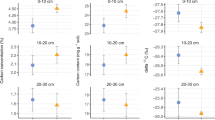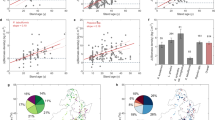Abstract
The current rise in atmospheric CO2 concentration is thought to be mitigated in part by carbon sequestration within forest ecosystems1,2, where carbon can be stored in vegetation or soils. The storage of carbon in soils is determined by the fraction that is sequestered in persistent organic materials, such as humus. In experimental forest plots of loblolly pine (Pinus taeda) exposed to high CO2 concentrations3,4, nearly half of the carbon uptake is allocated to short-lived tissues, largely foliage. These tissues fall to the ground and decompose, normally contributing only a small portion of their carbon content to refractory soil humic materials5. Such findings call into question the role of soils as long-term carbon sinks, and show the need for a better understanding of carbon cycling in forest soils. Here we report a significant accumulation of carbon in the litter layer of experimental forest plots after three years of growth at increased CO2 concentrations (565 µl l-1). But fast turnover times of organic carbon in the litter layer (of about three years) appear to constrain the potential size of this carbon sink. Given the observation that carbon accumulation in the deeper mineral soil layers was absent, we suggest that significant, long-term net carbon sequestration in forest soils is unlikely.
This is a preview of subscription content, access via your institution
Access options
Subscribe to this journal
Receive 51 print issues and online access
$199.00 per year
only $3.90 per issue
Buy this article
- Purchase on Springer Link
- Instant access to full article PDF
Prices may be subject to local taxes which are calculated during checkout
Similar content being viewed by others
References
Ciais, P., Peylin, P. & Bousquet, P. Regional biospheric fluxes as inferred from atmospheric CO2 measurements. Ecol. Appl. 10, 1574–1589 (2000).
Houghton, R. A., Hackler, J. L. & Lawrence, K. T. The U.S. carbon budget: contributions from land-use change. Science 285, 574–578 (1999).
DeLucia, E. H. et al. Net primary production of a forest ecosystem with experimental CO2 enrichment. Science 284, 1177–1179 (1999).
Hendrey, G. H., Ellsworth, D. S., Lewin, K. F. & Nagy, J. A free-air enrichment system for exposing tall forest vegetation to elevated atmospheric CO2. Glob. Change Biol. 5, 293–309 (1999).
Schlesinger, W. H. Evidence from chronosequence studies for a low carbon-storage potential of soils. Nature 348, 232–234 (1990).
Ellsworth, D. S. CO2 enrichment in a maturing pine forest: Are CO2 exchange and water status in the canopy affected? Plant Cell Environ. 22, 461–472 (1999).
Matamala, R. & Schlesinger, W. H. Effects of elevated atmospheric CO2 on fine root production and activity in an intact temperature forest ecosystem. Glob. Change Biol. 6, 967–980 (2000).
Cambardella, C. A. & Elliott, E. T. Methods for physical separation and characterization of soil organic matter fractions. Geoderma 56, 449–457 (1993).
Gill, R. A., Burke, I. C., Lauenroth, W. K. & Milchunas, D. G. Relationship between root biomass and soil organic matter pools in the shortgrass steppe of eastern Colorado. Ecosystems 2, 226–236 (1999).
Jastrow, J. D., Boutton, T. W. & Miller, R. M. Carbon dynamics of aggregate-associated organic matter estimated by carbon-13 natural abundance. Soil Sci. Soc. Am. J. 60, 801–807 (1996).
Andrews, J. A. Changes to Belowground Carbon Dioxide Dynamics under CO2 Enrichment of a Forest Ecosystem. Thesis, Duke Univ. (1999).
Olson, J. S. Energy storage and the balance of producers and decomposers in ecological systems. Ecology 44, 322–331 (1963).
Balesdent, J., Wagner, G. H. & Mariotti, A. Soil organic matter turnover in long-term field experiments as revealed by carbon-13 natural abundance. Soil Sci. Soc. Am. J. 52, 118–124 (1988).
Finzi, A. C., Allen, A. S., DeLucia, E. H., Ellsworth, D. S. & Schlesinger, W. H. Forest litter production, chemistry, and decomposition following two years of Free-Air CO2 Enrichment. Ecology 82, 470–484 (2001).
Jorgensen, J. R., Wells, C. G. & Metz, L. J. Nutrient changes in decomposing loblolly pine forest floor. Soil Sci. Soc. Am. J. 44, 1307–1314 (1980).
Lichter, J., Lavine, M. L., Mace, K. A., Richter, D. D. & Schlesinger, W. H. Throughfall chemistry in a loblolly pine plantation under elevated atmospheric CO2 concentrations. Biogeochemistry 50, 73–93 (2000).
Fox, T. R. & Comerford, N. B. Low-molecular-weight organic acids in selected forest soils of the southeastern USA. Soil Sci. Soc. Am. J. 54, 1139–1144 (1990).
Delucia, E. H., Callaway, R. M., Thomas, E. M. & Schlesinger, W. H. Mechanisms of phosphorus acquisition for ponderosa pine under high CO2 and temperature. Ann. Bot. 79, 111–120 (1997).
Jones, T. H. et al. Impacts of rising atmospheric carbon dioxide on model terrestrial ecosystems. Science 280, 441–443 (1998).
Hungate, B. A. et al. The fate of carbon in grasslands under carbon dioxide enrichment. Nature 388, 576–579 (1997).
van Kessel, C., Horwath, W. R., Hartwig, U., Harris, D. & Luscher, A. Net soil carbon input under ambient and elevated CO2 concentrations: isotopic evidence after 4 years. Glob. Change Biol. 6, 435–444 (2000).
Harrison, K., Broecker, W. & Bonani, G. A strategy for estimating the impact of CO2 fertilization on soil carbon storage. Glob. Biogeochem. Cycles 7, 69–80 (1993).
Cox, P. M., Betts, R. A., Jones, C. D., Spall, S. A. & Totterdell, I. J. Acceleration of global warming due to carbon-cycle feedbacks in a coupled model. Nature 408, 184–187 (2000).
Richter, D. D., Markewitz, D., Trumbore, S. & Wells, C. G. Rapid accumulation and turnover of soil carbon in a re-establishing forest. Nature 400, 56–58 (1999).
Schiffman, P. N. & Johnson, W. C. Phytomass and detrital carbon storage during forest regrowth in the southeastern United States piedmont. Can. J. Forest Res. 19, 69–78 (1989).
Delcourt, H. R. & Harris, W. F. Carbon budget of the southeastern U.S. biota: analysis of historical change in trend from source to sink. Science 210, 321–323 (1980).
Brown, S. L. & Schroeder, P. E. Spatial patterns of aboveground production and mortality of woody biomass for eastern U.S. forests. Ecol. Appl. 9, 968–980 (1999).
Schimel, D. et al. Contribution of increasing CO2 and climate to carbon storage by ecosystems in the United States. Science 287, 2004–2006 (2000).
Casperson, J. P. et al. Contributions of land-use history to carbon accumulation in U.S. forests. Science 290, 1148–1151 (2000).
Weisberg, S. Applied Linear Regression 114–117 (Wiley, New York, 1985).
Acknowledgements
We thank K. Harrison and J. Andrews for collecting pretreatment samples for covariance analysis; H. Hemric, R. Gill, M. Lavine and A. Mace for technical assistance; L. Giles for mass spectrometry analyses; and J. Clark, E. Davidson, L. Dellwo, A. Hirsch and D. Schimel for critical reviews of the manuscript. Operated in cooperation with Brookhaven National Laboratory, the Duke Forest FACE project is supported by the US Department of Energy.
Author information
Authors and Affiliations
Corresponding author
Rights and permissions
About this article
Cite this article
Schlesinger, W., Lichter, J. Limited carbon storage in soil and litter of experimental forest plots under increased atmospheric CO2. Nature 411, 466–469 (2001). https://doi.org/10.1038/35078060
Received:
Accepted:
Issue Date:
DOI: https://doi.org/10.1038/35078060
This article is cited by
-
Mycorrhizal type regulates trade-offs between plant and soil carbon in forests
Nature Climate Change (2024)
-
Forest microbiome and global change
Nature Reviews Microbiology (2023)
-
Litter accumulation and fire risks show direct and indirect climate-dependence at continental scale
Nature Communications (2023)
-
Carbon accumulation in soil layers under degraded, intact and planted forest cover types in tropical semi-deciduous and moist evergreen forests
New Forests (2023)
-
Drought reduces invasive grass performance by disrupting plant–microbe interactions that enhance plant nitrogen supply
Oecologia (2023)
Comments
By submitting a comment you agree to abide by our Terms and Community Guidelines. If you find something abusive or that does not comply with our terms or guidelines please flag it as inappropriate.



